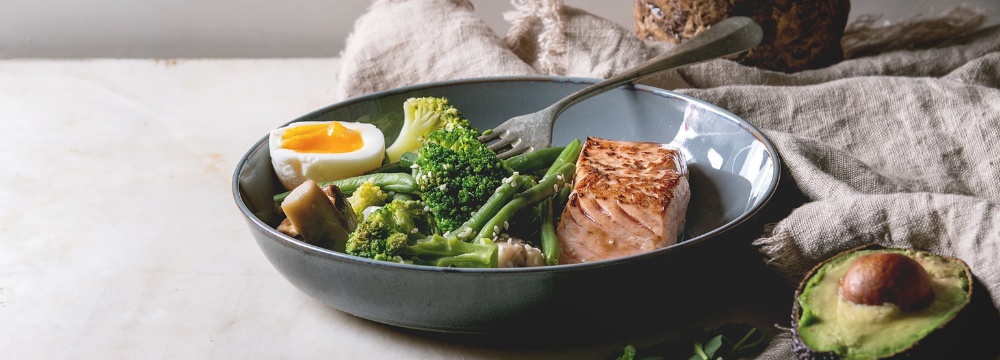Blog Archives
Power Up Post-Op: Protein, Carbs & Progress

Bariatric surgery marks a significant step, as it alters the way your body processes food, nutrients, and energy. Understanding the roles of carbohydrates and proteins—and how to balance them—will help you feel your best, heal well, and inspire long-term weight loss.
Let’s suss out the benefits of these two nutrients, how to choose the right types, and practical tips for making them work on your plate.
Protein Takes Center Stage Post-Surgery
Protein is the star nutrient after bariatric surgery for several important reasons:
- Healing and Repair: Protein helps your body rebuild tissues and keeps your immune system strong as you recover.
- Muscle Maintenance: As you lose weight, you also risk losing muscle mass. Protein helps preserve lean muscle, allowing you to stay strong and active.
- Satiety: Protein keeps you feeling full longer, which is helpful when your meals are smaller and stomach capacity is reduced.
Good protein sources include lean meats such as chicken and fish, eggs, low-fat dairy products, beans, lentils, and plant-based foods like tofu. You can also use protein powders or shakes to meet your daily requirements, especially in the early months after surgery.
Since your body is trying to reconfigure how it processes nutrients, it’s a good idea to check with your healthcare team for personalized recommendations on daily values.
Carbohydrates: Friend or Foe?
Carbs often get a bad rap, but they’re your body’s primary energy source and are necessary for good health, especially after surgery. The USDA Dietary Guidelines for Americans 2020–2025 suggest carbohydrates should make up 45–65% of your daily consumption of macronutrients (essential dietary components, including carbohydrates, protein, and fats), regardless of age.1 The trick is getting the right ones in the right amount.
The good ones are called complex carbohydrates. These come from whole foods such as vegetables, fruits, whole grains (like brown rice, oats, quinoa), and legumes. They digest slowly, providing steady energy, and are high in fiber, which helps improve digestion and blood sugar control.
Simple or refined carbohydrates are the ones you want to avoid. Consumables high in sugar, white bread, sodas, pastries, and other processed foods cause quick spikes in blood sugar and can lead to unwanted weight gain or dumping syndrome (when food moves too quickly from the stomach to the first part of the small intestine).
Choosing complex carbs helps you stay energized without unwanted side effects, so focus on fiber-rich options to maintain smooth digestion and stable blood sugar levels. And just like protein, get recommendations for your body’s specific needs from your care team.
Balancing Carbs and Proteins
Protein and carbs aren’t enemies – they play off of each other when they’re eaten in the proper proportions. Protein preserves muscle mass and makes a meal feel more satisfying. Complex carbs provide lasting energy and fiber for better digestion. When you give each of them their due space on your plate, they work in tandem to stabilize blood sugar, reducing cravings and energy crashes. Having those things in check gives you the motivation you need, both mentally and physically, to continue showing up for physical activity, meal prep, and all the daily activities that contribute to your ultimate goal: weight loss and improved overall health.
Build meals around protein first, then add a serving of fiber-rich carbs and healthy fats, such as olive oil or avocado. Since you’re eating smaller meals, this will help you focus on nutrient-dense foods that satisfy without overwhelming your stomach.
Making it Work
Let’s pull over for just a minute and touch on mindset. You aren’t doomed to boring meals! Healthier choices are simply more nutritious options. You can still enjoy a ton of flavor and a satisfying meal by experimenting with spices and herbs instead of salt, and using fruit instead of sugar. For example, applesauce is sweet and rich in vitamins, making it a suitable substitute for baked goods. It will take some getting used to, but you can find several ways to incorporate healthy alternatives.
A few extra tips include:
- Protein Variation: Don’t stick to just one or two sources. Variety keeps your meals interesting while also delivering a wide range of nutrients.
- Carb Craving Control: When cravings hit, reach for a piece of fruit or a small handful of nuts instead of candy or chips. A jar of walnuts or dried fruit is easy to keep at your desk or in the front of your pantry, so you’re less likely to consume something you’ll regret later.
- Smart Snacking: Pair protein with fiber, such as Greek yogurt with berries or hummus with vegetables. This goes back to the concept of working in tandem that we discussed earlier.
- Steady Sipping: Drink water between meals, and if you’ve found that hard to do, add a slice of lemon or lime to it. If you need a little more flavor, you can add electrolytes with trace minerals to your water. Be sure to check the sugar content, as some brands may contain more than others.
- Mind-Body Breaks: Take your time when you eat and notice how different foods affect you. It can be helpful to keep a mood journal alongside a food diary to track the synergy between the foods you eat and your emotions. This can be especially helpful for your care team, dietitian, and therapist as they assist you in making any necessary adjustments along the way.
Lean Into Progress
We often spend more time on the journey than we do at the destination – learn how to enjoy this one! Balancing your diet and re-engineering your habits after bariatric surgery is not a race. Each healthy choice you make moves you closer to your goals.
Keep in mind that you’re creating lasting habits that will serve you well. Celebrate your progress, learn from the bumps, and lean on your healthcare team when needed.
You’re worth every effort you put into your health, and the team at SAMPA is here to help.
Reference:
- United States Department of Agriculture. (2020). Dietary Guidelines for Americans 2020-2025. USDA. https://www.dietaryguidelines.gov/sites/default/files/2020-12/Dietary_Guidelines_for_Americans_2020-2025.pdf.
A Dash Here and a Pinch There: The Salt Spectrum

Pink, white, crystalline, or flaky, salt is salt. Right? Maybe… maybe not.
Salt has been blamed for bloating, praised for its preservation properties, and debated by chefs and doctors alike. For something so basic, it gets a lot of attention, influencing flavor, texture, and the way you enjoy food. But does the type of salt you consume matter, especially after bariatric surgery?
We’ll unpack how your body handles sodium, explore some popular types of salt, and polish it off with a bonus fact to add some flavor to your day.
Your Body Needs a Bit of Salt
It’s almost mantric: Cut back on sodium to lower your blood pressure. A substantial body of research also backs it. The Centers for Disease Control and Prevention (CDC) recommends that most adults consume less than 2,300 mg of sodium per day, roughly equal to one teaspoon of salt. However, most Americans eat well beyond that, increasing their risk for hypertension, stroke, and heart disease.¹
When you consume more sodium than your body needs, your kidneys may struggle to eliminate it efficiently. To dilute the excess, your body retains water, increasing blood volume, which can raise blood pressure and cause your heart to work harder. Over time, this strain can contribute to high blood pressure, heart failure, or kidney problems. Some research even suggests that high sodium intake can negatively impact your heart and bones independently of blood pressure.²
Most unprocessed foods, such as produce, some meats, and whole grains, are naturally low in sodium. However, when the bulk of your diet consists of packaged and restaurant foods, excess daily sodium can sneak in too easily. According to the CDC, the most significant sources of sodium, even from the grocery store, include bread, pizza, deli meats, salty snacks, and cheese.³
Hearing what sodium does when we consume too much might put a bad taste in our mouth, but we also need it, at least 500 mg per day, to be exact.2 Salt is a chemical compound of sodium and chloride that we need for controlling the movement of water in and out of cells. It’s also vital for proper nerve signal transmission and muscle contraction, including heartbeats. Both deficiency and excess can lead to serious health problems.
Types of Salt
Now, let’s get to the fun part: exploring the variety of salts available. Whether you’re sprinkling it on avocado toast or seasoning soup, here’s how common salts compare. (Just keep moderation in mind!)
1. Regular Table Salt
This is the salt you see in most saltshakers. Highly refined, table salt is stripped of trace minerals and often blended with anti-caking agents to prevent clumping. It’s also usually iodized, a process introduced in the early 20th century to avoid iodine deficiency and goiter.
Table salt is ubiquitous, appearing in everything from diners to baking recipes, and is a staple on almost every American countertop. If you need iodine in your diet (and most people do), this is a reliable source, but it should be used conservatively. Because it’s finely ground, it packs more sodium into a smaller volume compared to coarser salts. A teaspoon of table salt may deliver more sodium than a teaspoon of flaked or coarse salt – something to consider when you’re watching your intake.
2. Kosher Salt
Kosher salt is coarser and flakier than table salt, with a clean taste and typically no additives. Despite the name, it isn’t necessarily “kosher”- the name comes from its use in koshering meat to draw out blood during the curing process.
This type of salt is used for cooking and seasoning meats, but it usually doesn’t contain iodine, so don’t rely on it for that nutrient – it’s just sodium. A bonus to this type of salt is that its larger crystals mean it’s less dense than finely ground salt. Because of its clean flavor and coarse texture, it’s ideal for dry rubs, roasting vegetables, seasoning pasta water, or sprinkling over meat before grilling.
3. Pink Himalayan Salt
Harvested from ancient sea beds in Pakistan, this pink-hued salt is rich in trace minerals like magnesium, calcium, and iron, which gives it its rosy color. While you may see products labeled as “Himalayan salt” from other countries, these are often imitation products. If it’s not from Pakistan, it’s not truly Himalayan salt. In the culinary world, it’s usually used for finishing dishes or adding visual flair.
Himalayan pink salt pairs well with roasted vegetables, grilled meats, or grain bowls. Although its mineral content doesn’t seem to offer significant health advantages, some people enjoy its slightly earthier flavor.
4. Pickling Salt
Also known as canning salt, this type is entirely free of additives and anti-caking agents, making it ideal for making brines or pickling where cloudiness is a no-go. Brines help tenderize meats and infuse them with flavor before cooking, making this salt especially handy for prepping poultry or lean cuts.
Because it’s pure sodium chloride, it’s potent in flavor, so be careful if you use it for anything other than pickling. You also need to be cautious about storage, as it doesn’t contain the anti-caking agents that table salt does, which can cause it to clump in humid conditions.
5. Sea Salt
Evaporated from seawater, sea salt retains trace minerals depending on the water source. These minerals can lend subtle flavor differences depending on where they’re harvested. For example, French fleur de sel is harvested by hand from shallow salt ponds, and some people think it has a “bright” taste. Celtic sea salt, by contrast, is more mineral-rich and slightly gray with a deeper, brinier flavor.
The culinary application of this type of salt is in specialty recipes, where it provides texture and more depth than traditional table salt offers. Sprinkling it over fresh vegetables, fish, or lean grilled meats just before serving heightens the natural character of these healthy foods.
6. Black Salt (Kala Namak)
This volcanic rock salt from South Asia has a distinct sulfuric aroma thanks to its natural mineral content. It’s a staple in Indian cuisine and is often used in vegan recipes to mimic the taste of eggs.
Foods you’ll find this one in include chaats, chutneys, and tofu scrambles. According to Ayurvedic medicine, it may offer digestive benefits, though scientific backing is limited. This one is best used sparingly since its pungent flavor can easily overpower a dish.
When it comes to nutrition, the differences between salts are minimal. Be sure to read the nutrition labels to determine the amount of sodium per serving, as the amounts may vary slightly. And while you’re in the kitchen, have fun with it – try making the same dish using two different salts and see how their flavor profiles compare. Who knows? It might be just the thing that turns the task of overhauling your diet into something a little more exciting!
And Now for a Little History Flavor…
Salt has shaped trade routes, launched wars, and preserved entire food cultures – but did you know it also gave us a common expression?
The saying “worth your salt” dates back to ancient Rome. Roman soldiers were sometimes paid in salt or given a salt allowance, known as a salarium, from which the word “salary” originates. Salt was incredibly prized at the time, not just for flavor but for preserving food, making it an indispensable commodity.
So, when someone is “worth their salt,” it means they’re valuable or competent, just as a good worker was worth the salt they were paid.
And if you’re here, reading about what’s on your plate, you’re already worth your salt, taking the time to understand your food, make intentional choices, and stay on track with your health goals. At SAMPA, we know it isn’t easy, but it’s worth taking control of your health.
References:
- CDC. (2024). About Sodium and Health. CDC. https://www.cdc.gov/salt/about/index.html.
- Harvard T.H. Chan School of Public Health. (2023, March). Salt and Sodium. The Nutrition Source. https://nutritionsource.hsph.harvard.edu/salt-and-sodium/.
- CDC. (2024). About Sodium and Health. CDC. https://www.cdc.gov/salt/about/index.html.
Anti-Diarrheals and Their Intended Targets

We’re just going to say it – diarrhea is not pleasant. When it strikes, most people aren’t asking why; they just want relief. Fast. That pink liquid might be the icon of relief, but it doesn’t do the trick every time.
Loose stools can happen for a variety of reasons, and the aisle full of anti-diarrheal options targets different causes. Before you knock back a capful of bismuth (the pink stuff we know so well), it’s worth understanding what might really be going on.
Summer Socializing Post-Weight Loss Surgery

Just because you’ve made some significant modifications to your diet doesn’t mean you have to tiptoe around get-togethers. We’re social creatures, and being with people we care about is fundamental to our nature. If you’re wondering how you’ll go about sticking to your diet and not feeling overwhelmed with the menu while hanging out, we’re going to help you with a few pointers.
SAMPA’s Surgeons Named 2025 Nappie Award Finalists

It’s Nappie Time! That can only mean it’s time for the Nappie Awards—Lagniappe’s annual reader-voted celebration of the best people, places, food, and businesses along the Gulf Coast, especially in Mobile, Alabama. It’s a big deal for locals, with tons of community pride and friendly competition.
We are thrilled to announce that Dr. Barry Ballard Jr., Dr. Forrest Ringold, and Dr. Dusty Smith have been nominated for Best General Surgeon, while Dr. Barry Ballard Jr., Dr. Timothy Mansour, and Dr. Forrest Ringold have been nominated for Best Weight Loss Doc-Surgical, and Dr. Gregory Quatrino has been nominated for Best Butts and Guts Surgeon. We take immense pride in our nominated doctors and wish them luck!
We invite you all to vote and help spread the word about this excellent team of care providers. We appreciate all of your votes, each one truly does make a difference.
How Much Is Too Much Weight Loss Too Fast

With the advent of ever-improving bariatric techniques and technologies and the GLP-1 medication craze in Wegovy and Zepbound, many people are losing weight more quickly than ever. While this may seem like a great “problem” to have, it is possible to lose too much weight too fast. Let’s dive into why we want to moderate our weight loss and how to do so.
Choosing Between Bariatric Surgery & Weight Loss Medication (Wegovy & Zepbound)

Patients have a choice between multiple effective weight loss options for the first time in many years. Until recently, bariatric surgery was the only way for most obese patients to experience dramatic and sustained weight loss. However, our armamentarium has another option with weight loss medications like Wegovy and Zepbound, also known as GLP-1 receptor agonists. While these medications represent a very different weight loss modality compared to bariatric surgery, both can offer significant weight loss and are particularly effective when selected for the correct patients.
Getting Your Protein – From a Patient’s Perspective

By Chad Reott, SADI patient
Few of us understand how vital protein is to the human body until we need it to stay healthy. I’ll be honest—I did not. However, throughout my bariatric surgery and the ensuing process, I have learned a lot about protein and how it interacts with the body.
One of the things that stuck out to me most, and I had no fundamental understanding of, was when my sister, who is an ICU nurse, advised me that I needed this protein to help my body heal following my surgery and to prepare it before surgery. She was frustrated I wasn’t eating enough protein and suggested I may be increasing my risk of complications.
Alright, enough about me.
About Medical Weight Loss Options – Wegovy®, ZepBoundTM

With the availability and popularity of modern weight loss drugs like Wegovy® and ZepboundTM, patients have an ever-expanding tool chest for losing weight. We understand how difficult it can be to manage excess weight and obesity – we’ve helped tens of thousands do it for the past several decades. Until now, most patients have resorted to bouncing between diets (most tend to fail) as their only non-surgical weight loss option.
Those looking for an alternative will be pleased to know there are two weekly injectable weight loss drugs currently on the market. Wegovy is a derivative, high-dose version of the popular diabetes drug Ozempic®. Zepbound is the weight loss-approved form of MounjaroTM, a diabetes drug as well. The former is a Semaglutide, while the latter is a Tirzepatide. While they have different names, they essentially do the same thing. Both are GLP-1 receptor agonists. In other words, when injected into belly fat, these drugs stimulate an increase in beta cells within the pancreas and subsequently induce satiety and weight loss.
How to Succeed After Bariatric Surgery if Cardio’s Not Working

Your bariatric journey is lifelong, and you must stick to a diet and exercise routine to lose weight since these are the integral parts of every successful weight loss journey, regardless of the tool used. Recommendations after bariatric surgery boils down to following a defined and healthy diet punctuated by moderation and regular cardio and resistance exercise.
For some in early recovery after surgery, cardio exercises strain their joints or hearts too much. Some patients may need to lose weight or get a joint replacement to be more active. With luck, the weight loss afforded by bariatric surgery will improve joint pain and mobility. Getting to that point takes a lot of effort.
If cardio exercises aren’t your thing right now, don’t worry. Other effective ways to support your bariatric journey include diet and non-cardio exercises.

